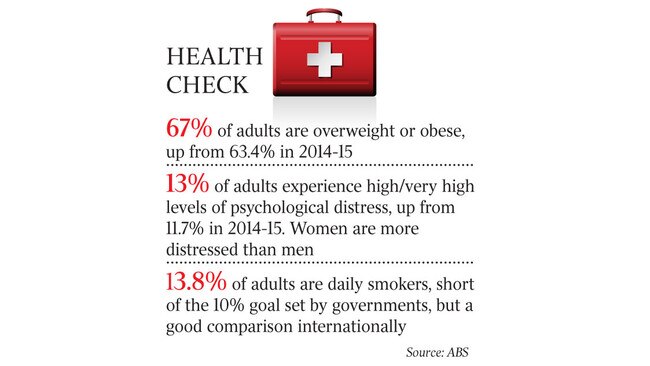Two thirds of Aussies deemed overweight or obese
Two thirds of Australian adults are overweight or obese.

Two-thirds of Australian adults are overweight or obese, as poor diet and inactivity undermines the long-term benefits of fewer people smoking or drinking to excess.
As political leaders argued over health funding yesterday, the Australian Bureau of Statistics released national survey results that should weigh heavily on the system. For the first time, two out of every three adults, or 67 per cent of the population, are deemed to be overweight or obese. That is based on self-reported height and weight, used to calculate the Body Mass Index, an imperfect but consistent measure for the survey.
The previous survey in 2014-15 put the figure at 63.4 per cent, but more Australians have slipped to the obese end of the scale. There has also been a surge in the proportion of 18 to 24-year-olds deemed overweight or obese, increasing from 38.9 per cent to 46 per cent over the period.

ABS director of health Louise Gates said the proportion of the population deemed obese had risen from 19 per cent in 1995 to 31 per cent in the last survey.
“Men were more likely to be overweight or obese than women, with 74.5 per cent men overweight or obese compared with 60 per cent of women,” she said.
Ms Yates said the typical Australian male weighed 87kg and stood 175cm tall while the typical female weighed 72kg and was 161cm tall. Both were overweight.
The ABS also surveyed waist measurements, another indicator of healthy weight, and found 59.6 per cent of men and 66 per cent of women had a circumference that put them at increased risk. Not surprisingly, only 51.3 per cent of Australian adults got their recommended two serves of fruit each day, only 7.5 per cent got five or six serves of vegetables, and 9.1 per cent drank sugar-sweetened drinks daily.
Physical activity guidelines were met by only 15 per cent of 18 to 64-year-olds, and 17.2 per cent of older Australians, with diet and exercise deteriorating after childhood. The survey also charted an increase in chronic conditions and mental illness, higher levels of psychological distress, and consistent high blood pressure. The proportion of smokers fell to 13.8 per cent and risky drinking continued to decline.



To join the conversation, please log in. Don't have an account? Register
Join the conversation, you are commenting as Logout